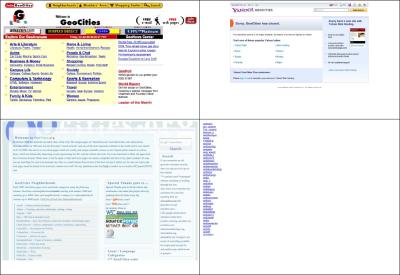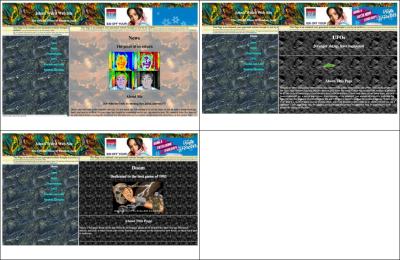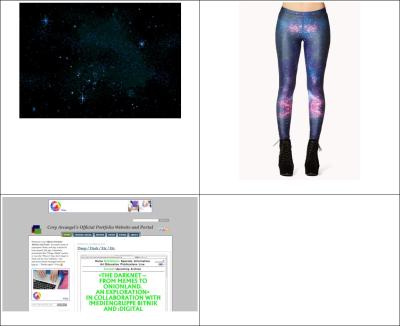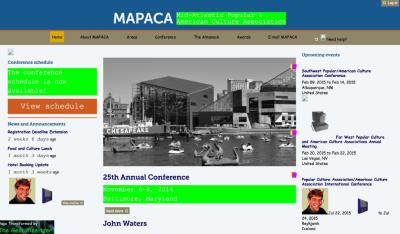
In this paper I ask how and why Geocities.com, a free web hosting service discontinued on October 27, 2009, has become a significant part of Internet history to which designers, artists, archivists, but also everyday Internet users return. Several archive sites, such as oocities, the Internet Archive, geocities.ws and others, have been trying to store and preserve as many Geocities websites as possible that would otherwise have been lost because Yahoo! shut down the hosting service. These efforts reveal as much about the early Internet user of the 90s and early 2000s as they do about our digital moment, 15 years after Geocities’ disappearance. While today we are jaded by seemingly unlimited access to each and every piece of information by the swipe of a finger on an iPad screen, the ruins of Geocities speak to us as a site of archaeological excavation. But what could be excavated, we might ask, and I ask that question today: do the websites spark something that we could call “Internet nostalgia,” or maybe “nostalgia for the future,” as it is impossible to restore Geocities in its original incarnation? Is Geocities a homepage one longs for but cannot return to, as the websites remain dead, vacant places that will forever be “un-updatable”? Is Geocities and its legacy still, after 15 years, able to hold a mirror to our faces and offer commentary on our Internet culture today? Ultimately, the Geocities archives might trigger a similar effect as those of time capsules, messages in a bottle washed upon shore, and Parisian apartments untouched for 70 years–bewilderment, amusement, or astonishment for times past and versions of ourselves now inaccessible.
Let me facetiously suggest that we can understand Geocities as a digital-age addition to the long list of lost and restored mysterious cities that are steeped in legend, that have been adapted over and over again in novels, television series and Brad Pitt movies. Rome, Troy, Atlantis, Geocities–the list goes on and on, and these cities become sites for times past, in which time, in fact, appears to stand still. Geocities went through a rise and fall before becoming an icon of the Internet itself. In 1994 Beverly Hills Internet started Geocities as a free web hosting service. For the next 15 years Geocities offered its users webspace to upload content anonymously–in effect, millions of mostly amateurish websites were generated and uploaded to Geocities. Site users were to choose a neighborhood or city in which to build their website: “Hollywood” gathered websites about celebrities, “WestHollywood” about gay, lesbian, bisexual and transgender topics, “Pentagon” about the military, or “Vienna” about classical music and opera. Users therefore had to self-categorize their websites and choose a neighborhood accordingly. At one point, Geocities was the 3rd most visited website on the Internet and, in the midst of the millennial dot-com craze, was ultimately bought by Yahoo! for almost $4 billion in 1999. Only ten years after its acquisition, Yahoo! decided to shut the service down because Geocities.com was not as profitable as Yahoo! had hoped it would be– probably because times on the internet changed and Geocities was succeeded by social networks like Myspace and Facebook. Even though Geocities was still in the top 200 of the most frequented websites, the service had to go, and ultimately about 38 million websites were erased from Yahoo!’s servers.
The Internet Archive, oocities, reocities, and geocities.ws opposed this deletion and archived as many websites as possible before October 27, 2009. They understood Geocities’ legacy to be more than its amateurish websites with blinking GIFs and terrible MIDI music in the background. Geocities bears witness to the peculiar early Internet of the late 1990s, when everyday users discovered the web as a space for self-expression. For many, a Geocities website was the first contact with the Internet, either as a creator / webmaster or as a visitor. Oocities mission statement states that Geocities is “a living memorial on early Web culture” and the archive serves as an “effort to maintain an amazingly extensive collection of information” (Oocities.org). Their “aim is to save those pages which are worthy and unique scientific sources or are of great public interest as well as those, which are historically interesting or just representing the 90’s website culture and style” (Ibid.). The Archiveteam wiki is even more drastic when it comes to Geocities’ shutting down: “Yahoo! succeeded in destroying the most amount of history in the shortest amount of time, certainly on purpose, in known memory. Millions of files, user accounts, all gone. ArchiveTeam accepted the challenge and saved it. It’s forever available for everybody to play with.” (ArchiveTeam) They point out how “GeoCities was for millions of people the first experience dealing with the lowcost, full-color, world-accessible website and all the possibilities this contained. To not at least have the option of browsing these old sites would be a loss of the very history of the web from the side of the people who came to know it, not the designers who descended upon it.” (Ibid.)
Thus, I want to argue that the vanishing of Geocities has triggered archival and artistic responses and initiated discussions on what the Internet can and should remember; but it also bears witness to the first attempts at self-expression, creativity, and, no less, selfcategorization and self-marketing on the Internet. Before I proceed, let me briefly show you what was mourned after Geocities’ demise and now resurrected through archival practices.

Particularly the drive to keep Geocities alive and somehow navigable as a living testament of Internet culture prompts the question about archives and their theoretical and even affective implications. As Hal Foster points out in his article “An Archival Impulse,” “all archival material is found yet constructed, factual yet fictive, public yet private” (5). Traditionally, archives have had an interesting aura: slightly obsolete, abandoned places with organizational logic that makes the archive a system, but one which is not always understandable or accessible to an outsider. But suddenly, in the age of the internet, archives are popping up everywhere, and they are different. Even our email screens offer us the option to “Archive.” We are miniarchivists ourselves in the information society. The archive-oriented media theory of Wolfgang Ernst elaborates on the tension between and convergence of analog and digital archival practices. What Ernst calls “media archaeology,” or archival media theory, is especially useful for my purposes today (18). Ernst outlines that media archaeology is less about telling stories or even counterhistories than it is about how stories are recorded, in what kind of media, through which kinds of processes. He performs an archaeology of the apparatus that conveys the past as fact, not just as story. Without diving further into Ernst’s theory, I want to point out that his work insists on taking into account the specificity and history of the medium—that the medium’s past might itself present archival materials and impulses, in addition to or beyond the matter itself that is archived. Is it possible, in the case of Geocities, to excavate the meaning of early Internet technology (an archeological method) and its content of posts and texts and images? Or, to ask it differently: should we really treat the Geocities archives as archives, or is this is a misnomer?
Geocities looks like a nostalgic message-in-a-bit-bottle, yet, these messages don’t just wash upon the shore; rather the archive dweller needs to know how to navigate the archive: The Internet Archive’s archive relies on the user knowing what she is looking for, having a specific URL in mind. With oocities, Geocities’s websites became re-organized not only within their neighborhoods, but also alphabetically, creating new neighbors by accidental, alphabetic association. You would either have to know an exact address or browse through the long lists of weird nicknames. All of this without a merciful archivist or librarian to guide you through the stacks! This speaks to how archives rearrange memory in a new order: the long list gives the impression of linearity, but it ultimately alters memory and the overall purpose of the neighborhoods through its new design. I am more intrigued, then, how thinking about the Geocities archives can give memory and nostalgia a new shape or, rather, how archives are able to alter memory and affect by a new ordering.
In her book The Future of Nostalgia, Svetlana Boym draws out two kinds of nostalgia that serve as good vantage points on the discussion of Geocities. She coins the term “reflective nostalgia,” which “dwells in algia, in longing and loss” (41). But she also draws attention to “restorative nostalgia,” which puts its emphasis on nostos, which is the idea of returning home from a long journey and proposes to “rebuild the lost home and patch up the memory gaps” (Ibid.). She continues: “Restorative nostalgia manifests itself in total reconstructions of monuments of the past, while reflective nostalgia lingers in ruins, the patina of time and history, in the dreams of another place and another time” (Ibid.) I find Boym’s definition extremely useful for thinking about Geocities as both a site for algia, for longing and loss, but also for nostos, the Greek word for homecoming. It is a restored place on the internet, kept alive in the archives, that can never be updated again. It is a dream of another place, another website, that can patch up the gaps of how the Internet and its users came into being. Tying this back to Ernst’s idea of how the medium can reveal practices and archival processes, Geocities can be treated as both a restored place and a ruin, anticipating the future while lingering in the past, triggering longing and loss all the while serving as inspiration for the future of the Internet.
This makes me think about the early drive to self-categorization and self-marketing that the Internet has brought about. Geocities did not provide a template or grid like Myspace or Facebook to store and represent information about their members, but the users had to design their own rudimentary websites and labor for hours over the HTML codes and Geocities’ upload practices. This underscores the self-representational dimension that Geocities demanded: it is labor. The affective gap exposed by the ruins of Geocities speaks to Foster’s juxtapositions for the archives. To argue even more forcefully, the disappearance of Geocities also threatened a discontinuation of the self that has been stored on the Internet and categorized and represented in Geocities’ neighborhoods. What if the Geocities users themselves are public yet private, found yet constructed, factual yet fictive?
The homepage of the user great_wise_yoda speaks profoundly to this and echoes my assumptions on Geocities as a place the self can and cannot return to. I found great_wise_yoda’s website randomly while clicking through the oocities archive, but it draws attention to the maybe naïve, maybe clueless self-representation that savvy Internet users today can only smirk at. Sections on UFOs, programming, the computer game Doom and random thoughts, which reads like a weblog, make up the majority of his website and could be understood as a precursor for fanpages on facebook, twitter updates, and likes. Only back then, great_wise_yoda had to design each and every page and had to put more effort into his self-representation that simply clicking on re-blog. 15 years later, he is here, unearthed again from archives, as an example on nostalgia.

great_wise_yoda says that his website is not much:
… but I’m adding stuff all the time, so just be sure to keep checking back, and maybe in 20 or 30 years there just might be something useful and informative here. […] I just created this place so that I could join the billions of internet users and try to express myself to the world by having a web site that nobody visits (at that end, I’ve been very successful; nobody does visit). Anyways, I hope you enjoy all the hard work I’ve put into making this place great (yeah, right, I update it what, maybe once or twice a year now).
Many websites like these are still online–and purposefully so–stored in the Geocities archives as abandoned remnants of an Internet age past. They are probably forgotten already by their designer, and the source code can never be accessed, let alone updated again. Both restorative nostalgia and reflective nostalgia play into this, even already at the time that great_wise_yoda created this website. He imagined that Geocities might be a place he, or others, would return to, long after he abandoned the website and moved on. To stress the strange temporality of this: he is writing about the future in which his presence is already past. Present and future are intertwined and anticipated: Geocities might be understood not only as a sight for artistic and nostalgic unearthing and return, but also as a witness to the nascence of the “internet user,” of the subject position of the internet user and her first attempts at selfrepresentation and categorization. But today nobody is called “webmaster” anymore, but we just seem to float along the stream of information our friends post. I should also point out that geocities worked differently–there was no app for it, the websites were not optimized for touch-screen tablets, and the most common Internet connection would have been through a dial up modem. At first sight, returning home is possible after 20 or 30 years, through new, improved, faster devices–yet is also remains impossible: there is a version of the self to which we have limited access, with broken images and mute MIDIs, and we cannot update it any longer. As blogger Rick Aristotle Munarriz points out, “Many of the pages were created years ago, and abandoned like bunny rabbits after Easter Sunday, Ugg boots after winter, and anything Reeves did after the first Matrix movie.” Our past selves, if we can unearth them in the bulk of archived websites, are 14-year-old bored teenagers playing DOOM, surrounded by nervous GIFs, and were last updated in November 1999, waiting to be unearthed in November 2014.
What Geocities and its exemplary website great_wise_yoda anticipated are the ruins of the future already present on their websites today. In light of this, I want to spend the last remaining minutes contemplating the competing or parallel temporalities that are present in archives and in the Geocities websites in particular. The future of nostalgia, to borrow from Boym, is traceable in the longing for a place past but weirdly accessible in a digital archive, like Geocities. The past and the expectations of the future seem to co-exist in the websites. The fact that great_wise_yoda’s musings of his website are relevant 10 years after they were written is one example. Similar to this, galaxy leggings currently sold at Forever 21 remind us of the background images that made it even harder to read the long texts of the webmasters on Geocities. Or Cory Arcangel’s website, which is decidedly “tacky” and “old-school.”

This brings the power of Geocities’s ruins to the fore: the user either needs to know where to look or she has to dive into the archives and excavate, brush away dust, labor over the long lists of nicknames to find traces of yesterday and of her past selves. This is not unlike the (imagined) process of sifting and sorting through a dusty analog archive. Present, past and future become re-aligned into one bulk of user name lists and seem to be able to co-exist and be anticipated simultaneously. With the past still intact, the present and future sneaks in everywhere: while I was surfing the websites, the contemporary ad banners were still working, advertising Gap jeans and shoes I had just looked at a couple of hours prior– anticipating me returning again for those jeans. So if there is a “new” kind of “digital nostalgia,” it is also as nostalgia always is–intimately bound up with former selves. Maybe our nostalgia for Internet times past is heightened by its perceived ephemerality–we enjoy the nostalgia of Geocities because we can perceive the inaccessible home and self it offers as especially fleeting. Or manifest, since we only need to dwell in the archives long enough to find ourselves again. Maybe mastering the Geocities archives and browsing through this longlost jungle also offers us, today, a certain kind of pleasure to show us how far we have come in the last 20 years of Geocities’s existence. We enjoy seeing across this temporal and spatial distance in the medium and in the self, and in the development of the Internet as a tool for communication across the globe. Can we be glad that our former selves exist only in pixels that aren’t so hard to delete? Or can we be glad that there is always a way to “come home,” to return to the sights long lost and forgotten? Or that we can create places that look like home easily, with a tool like the Geocities-izer?

References
Boy, Svetlana. The Future of Nostalgia. New York: Basic Books, 2001. Print.
Ernst, Wolfgang. Digital Memory and the Archive. Minneapolis, London: University of Minnesota Press, 2013. Print.
Foster, Hal. “An Archival Impulse.” October 110 (Fall 2010), 3-22. Print.
Geocities Special Collection 2009. Internet Archive - Wayback Machine, 2009. Web. November 5, 2014. <(https://archive.org/web/geocities.php)>
“Geocities.” ArchiveTeam Wiki, October 8, 2014. Web. November 4, 2014. <(http://archiveteam.org/index.php?title=GeoCities)>
“John’s Weird Web Site - The Official Home of Random Junk.” great_wise_yoda. Oocities.org, no date. Web. November 5, 2014. <(http://www.oocities.org/great_wise_yoda)>
Milian, Mark. “Geocities’ time has expired, Yahoo closing the site today.” Los Angeles Times. LA Times, October 26, 2009. Web. October 20, 2014. <(http://latimesblogs.latimes.com/technology/2009/10/geocities-closing.html)>
Munarriz, Rick Aristotle. “Razing Yahoo!’s GeoCities.” The Motley Fool - To Educate, Amuse & Enrich. The Motley Fool, April 24, 2009. Web. November 5, 2014. <(http://www.fool.com/investing/high-growth/2009/04/24/razing-yahoosgeocities.aspx)>
Oocities.org - A Living Memorial on Early Web Culture and an Effort to Maintain an Amazingly Extensive Collection of Information. Oocities.com, 2009. Web. November 5, 2014. <(http://www.oocities.org)>